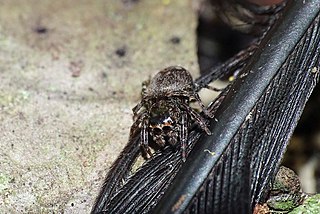
The Sri Lanka spurfowl is a member of the pheasant family which is endemic to the dense rainforests of Sri Lanka. In Sri Lanka, this bird is known as haban kukula - හබන් කුකුලා in Sinhala.

Queen Lilavati was the fourth woman in Sri Lankan history to rule as sovereign in her own right. Lilavati rose to prominence as the wife of Parakramabahu I, king of the Kingdom of Polonnaruwa. Being of royal descent herself, she then ruled as sole monarch on three occasions in the near-anarchy following Parakramabahu's death, with the backing of various generals. The primary source for her life is the Culavamsa, specifically chapter LXXX.

Onomastus is a genus of Asian jumping spiders that was first described by Eugène Louis Simon in 1900. It is the only genus in the subfamily Onomastinae.
Flacillula is a spider genus of the jumping spider family, Salticidae, with five described species that occur in the Southeast Asian region. It is closely related to the genus Afraflacilla.

Tetrablemmidae, sometimes called armored spiders, is a family of tropical araneomorph spiders first described by Octavius Pickard-Cambridge in 1873. It contains 126 described species in 29 genera from southeast Asia, with a few that occur in Africa and Central and South America. Pacullidae was incorporated into this family in 1981, but was later restored as a separate family in a 2016 phylogenetic study.

Poecilotheria is a genus of tarantulas native to India and Sri Lanka. It was first described by Eugène Louis Simon in 1885. They are arboreal tarantulas, commonly known as ornamental tarantulas, known for their vivid color patterns, fast movement, and potent venom compared to other tarantulas. As of 2019 all species are protected under CITES.
Wildlife of Sri Lanka includes its flora and fauna and their natural habitats. Sri Lanka has one of the highest rates of biological endemism in the world.
Anikanga was King of Polonnaruwa in the thirteenth century, who ruled from 1209 to 1209. He succeeded his son Dharmasoka, who was installed as king of Polonnaruwa, and was succeeded by Queen Lilavati. He reigned for 17 days. He allied with the Cholas and invaded Polonnaruwa to capture the throne.

Poecilotheria rajaei is a tarantula in the genus Poecilotheria endemic to Sri Lanka.
Campostichomma is a genus of spiders in the family Udubidae native to Sri Lanka. Many of its species were moved to either Griswoldia or Devendra. This genus was originally placed in the family Agelenidae. It was moved to Miturgidae in 1967, to Zoropsidae in 1999, then to Udubidae in 2015.

Poecilotheria vittata, sometimes called Pederson's ornamental, the ghost ornamental, or magam tiger spider, is an arboreal tarantula. It is endemic to Sri Lanka. In IUCN Red List, the species is cited as a synonym of Indian species Poecilotheria striata, but in other local text books and online publications, it is cited as a separate species. As of February 2016, the species was considered to be native to both India and Sri Lanka by the World Spider Catalog.
Shearella is a genus of Asian araneomorph spiders in the family Tetrablemmidae that was first described by Pekka T. Lehtinen in 1981.
Shearella selvarani is a species of spiders of the genus Shearella. It is endemic to Sri Lanka.
Aprusia is a genus of goblin spiders in the family Oonopidae, containing five accepted species. four species are endemic to Sri Lanka and the other species is endemic to India.

Curubis is a genus of Asian jumping spiders native to India and Sri Lanka which was first described by Eugène Louis Simon in 1902. As of 2019 it contains four species.







